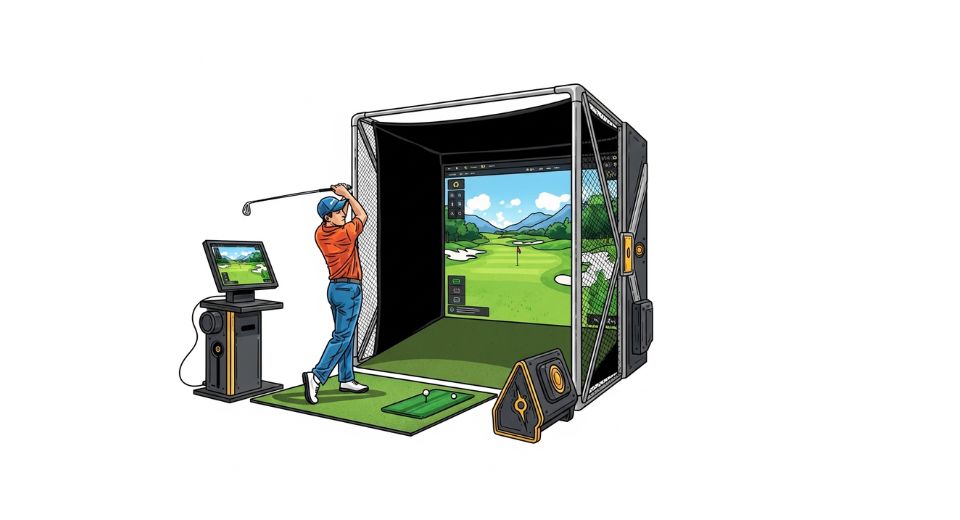Golf Simulators Market To Reach $3,718.43 Million by 2032

Insights shared through the latest publication by Metastat Insight offer a detailed observation into how the Global Golf Simulators Market is gradually shaping itself in response to nuanced shifts in user engagement, technological refinement, and changing leisure preferences. Golf simulators, once limited to niche enthusiasts and high-end golf training facilities, have found their way into a variety of settings. From residential basements to hospitality lounges and urban entertainment venues, these systems are being adopted as a way to bring the golf course indoors without compromising the feel of the sport. Their blend of technology and experience has turned what was traditionally a weather-dependent outdoor pursuit into a flexible, year-round activity.
Golf, historically linked with expansive green landscapes, structured etiquette, and time-consuming play, has encountered new patterns in user behavior. The simulator format responds to a modern lifestyle where time is often fragmented, yet the demand for engaging, skill-based leisure activities remains strong. What sets golf simulators apart is not only the immersive gameplay but also the capacity to provide detailed feedback, refine technique, and foster a social environment, all within the confines of a controlled space. This has opened the door for both avid golfers and casual participants to experience the game in a new light.
The setup of golf simulators varies widely, from pared-down arrangements that cater to the casual user to highly sophisticated systems designed for professional training. Across this spectrum, what remains constant is the demand for accuracy and interactivity. Sensors, projection systems, and user interfaces have evolved to a point where simulated play captures not just ball trajectory, but nuances such as club speed, swing path, and impact angle. Such precision is valued across skill levels, whether it's a hobbyist seeking improvement or a seasoned player keeping their edge sharp in the off-season.
Developers within this sector continue to explore how design and digital integration can create more life-like experiences. Visual realism, course variety, and adaptability in play conditions add depth to the user experience. Simulators can recreate globally renowned golf courses with remarkable detail, enabling users to play in environments they may never physically visit. The sensory aspects, including feedback sounds, simulated wind resistance, and responsive surfaces, further ground users in the experience. While the systems were initially viewed through a technical lens, today they are just as much about entertainment, connection, and accessibility.
Golf simulators also intersect with the social aspects of the sport in increasingly engaging ways. While traditional golf has often been viewed as a solitary or small-group activity, simulators support formats that include tournaments, team play, and multiplayer modes. For corporate settings, this opens up team-building opportunities; in hospitality environments, it becomes a feature attraction; and in residential settings, it provides a gathering point for family and friends. The ability to share a competitive yet low-pressure experience has broadened the simulator’s appeal well beyond the golf community.
Adaptability is a strong suit in the Global Golf Simulators Market. The systems can be installed in varying spatial layouts and tailored to meet different levels of technical complexity and space constraints. This allows venues with limited square footage to offer a meaningful experience without extensive renovation. Even temporary setups, such as pop-up events or exhibitions, benefit from the transportable and customizable nature of some simulator designs. As a result, new entrants and established venues alike find opportunities to use simulators as strategic tools to attract, retain, and engage users.
Professional use cases continue to influence how simulators are valued, particularly in training centers and coaching academies. Instructors can assess player performance using real-time metrics, replay features, and analytical breakdowns. The consistency and repeatability of simulator sessions eliminate environmental variables, allowing focused skill development. For elite athletes, simulators have become a dependable part of their training repertoire, supplementing on-course practice with data-driven insights.
Furthermore, the alignment of simulators with broader technology ecosystems adds layers to their application. Integration with wearable tech, mobile apps, and cloud storage allows users to monitor their performance over time, share progress with coaches, or even connect with fellow players across the world. This connectivity brings a sense of continuity to the simulator experience, making it more than a standalone encounter. It transforms the golf simulator into a part of a wider digital lifestyle, aligning with how individuals increasingly consume media, track fitness, and pursue recreational goals.
The collection of observations featured in the Global Golf Simulators Market Report presented by Metastat Insight reflects the depth and direction of an industry that continues to refine how sport, technology, and entertainment converge. With offerings that support both personal development and shared experiences, golf simulators have moved well beyond being just high-end gadgets. They now sit at the intersection of precision, accessibility, and enjoyment. As interest continues to develop in flexible, immersive experiences that blend skill-building with social interaction, the Global Golf Simulators Market remains positioned to meet these expectations with inventive approaches and increasingly sophisticated solutions.
Insights presented by the recent report from Metastat Insight present a close observation into the manner in which the Global Golf Simulators Market is slowly molding itself based on subtle changes in user adoption, technological improvement, and evolving recreational tastes. Golf simulators, previously confined to specialized enthusiasts and upmarket golf training centers, have penetrated a wide range of environments. From home basements to hotel lounges and city entertainment centers, the systems are being embraced as a method of taking the golf course indoors while not sacrificing the nature of the game. Their synergy of technology and expertise has transformed what was once a weather-sensitive outdoor activity into a malleable, year-round pursuit.
Golf, once associated with large green expanses, formalized etiquette, and slow play, has been faced with new user patterns. The simulator style meets the needs of a contemporary life in which time is frequently broken up, but still there is a strong demand for active, skill-based recreations. What makes golf simulators unique is not only the engaging play but also the ability to offer extensive feedback, polish technique, and create a social atmosphere, all within the context of a controlled environment. This has made it possible for both serious golfers and occasional users to enjoy the game in a new way.
The configuration of golf simulators ranges from minimalist arrangements intended for the casual user to highly advanced systems intended for professional instruction. Throughout this range, one thing that does not vary is the need for precision and interaction. Sensors, display systems, and interfaces have come to the point where simulated play records not only ball flight, but subtleties of club speed, swing direction, and impact position. That level of accuracy is appreciated at all skill levels, whether a beginner wants to get better or a professional stays sharp during the off-season.
Developers in this industry continue to seek out ways in which design and digital convergence can produce more life-like experiences. Visual realism, course diversity, and flexibility in play conditions enhance the depth of the user experience. Simulators are able to replicate globally celebrated golf courses with astonishing detail, allowing for users to play in environments they might never actually visit. The sensory elements, such as feedback noises, wind resistance simulation, and responsive surfaces, further immerse users in the experience. While the systems were initially considered from a technical perspective, they are now equally about entertainment, connectivity, and accessibility.
Golf simulators also converge with social elements of the game in more engaging ways. Whereas traditional golf has generally been considered an individual or small-group sport, simulators facilitate configurations that include tournaments, team play, and multiplayer. In corporate environments, it introduces team-building possibilities; in hospitality, it becomes a destination amenity; and in home environments, it serves as a focal point for family and friends. The capacity to provide a competitive but low-pressure experience has expanded the simulator's market far beyond the golfing community.
Flexibility is one of the Global Golf Simulators Market's greatest strengths. The systems can be installed in anything from a simple, rectangular configuration to an elaborate, irregularly shaped arrangement and can be set up to accommodate varying degrees of technical sophistication and space limitations. This means that facilities with limited square footage can provide a valuable experience without major renovation. Even short-term installations, like pop-up exhibitions or events, gain from the mobile and flexible aspect of certain simulator designs. New entrants and established venues both gain opportunities to employ simulators as strategic assets in winning, retaining, and engaging users.
Professional applications remain a driving factor in the way simulators are appreciated, especially in training facilities and coaching schools. Teachers can evaluate player performance based on real-time data, replay functions, and analytical analysis. The repeatability and consistency of simulator sessions reduce environmental factors, enabling skill development to be intensified. To top players, simulators now form a reliable component in their training arsenal, augmenting on-course training with data-driven information.
In addition, the integration of simulators with larger technology systems gives them added depth of use. Coupling with wearable technology, smartphone apps, and cloud storage enables users to track performance over time, forward scores to coaches, or even interact with other players worldwide. This integration introduces continuity to the simulator experience, one more than an isolated encounter. It transforms the golf simulator into a part of a wider digital lifestyle, aligning with how individuals increasingly consume media, track fitness, and pursue recreational goals.
The collection of observations featured in the Global Golf Simulators Market Report presented by Metastat Insight reflects the depth and direction of an industry that continues to refine how sport, technology, and entertainment converge. With products that enable both individual growth and communal connection, golf simulators have evolved far beyond the realm of mere luxury devices. Today, they reside at the nexus of accuracy, accessibility, and playfulness. As interest continues to cultivate flexible, immersive experiences that intersect skill acquisition and social engagement, the Global Golf Simulators Market sits poised to fulfill these expectations through innovative methodologies and increasingly advanced solutions.
Drop us an email at:
inquiry@metastatinsight.com
Call us on:
+1 214 613 5758
+91 73850 57479
 Agriculture
Agriculture
 Aerospace and Defense
Aerospace and Defense
 Automation & Process Control
Automation & Process Control
 Automotive and Transportation
Automotive and Transportation
 Banking & Finance
Banking & Finance
 Biotechnology
Biotechnology
1.png) Chemicals and Materials
Chemicals and Materials
 Consumer Goods
Consumer Goods
 Energy and Power
Energy and Power
 Food and Beverages
Food and Beverages
 Healthcare IT
Healthcare IT
 Information & Communications
Information & Communications
 Manufacturing and Construction
Manufacturing and Construction
 Packaging
Packaging
 Pharmaceuticals
Pharmaceuticals
 Electronics and Semiconductor
Electronics and Semiconductor
 Medical Devices
Medical Devices







 US: +1 3023308252
US: +1 3023308252






